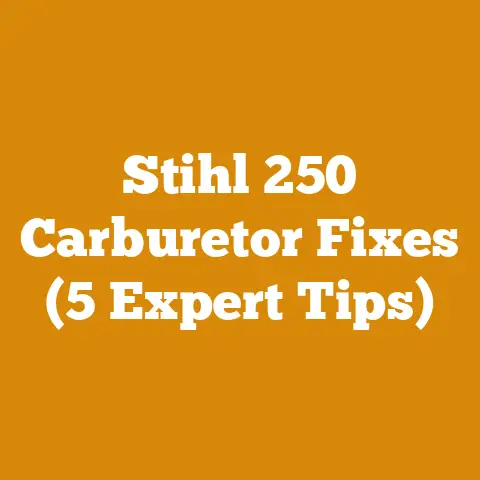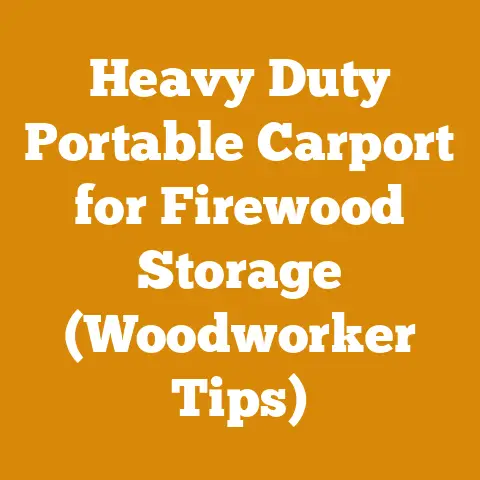Corn for Pellet Stove Heating (5 Proven Tips for Efficient Fuel Use)
Introduction: Corn for Pellet Stove Heating (5 Proven Tips for Efficient Fuel Use)
Okay, folks, let’s talk about something a little… unconventional. We all know and love our wood-burning stoves, fireplaces, and especially pellet stoves for keeping our homes warm and toasty. But what if I told you there was another fuel source you could potentially use in your pellet stove? I’m talking about corn.
Now, before you picture me shoveling popcorn kernels into a hopper, let’s clarify: we’re talking about shelled corn, the same kind used for animal feed and ethanol production. It’s a renewable resource, and in some regions, it’s significantly cheaper than traditional wood pellets. I’ve seen firsthand the wear and tear that constant use puts on pellet stoves, and I know the frustration of rising fuel costs. Exploring alternative fuels is a smart way to keep your heating bills down and your stove running smoothly.
I’ve been working with wood, chainsaws, and heating systems for over 20 years, and I’ve seen a lot of trends come and go. I remember when everyone thought wood chips were the next big thing – and while they certainly have their place, they never quite lived up to the hype for home heating. But corn… corn has some real potential, if you do it right.
The global wood pellet market is booming. Current estimates place the market size at over $9 billion, and it’s projected to continue growing at a rapid pace. This increased demand drives up prices, especially during peak heating season. Exploring alternative fuel sources, like corn, can offer a buffer against these price fluctuations. However, it’s crucial to understand the nuances involved to avoid damaging your pellet stove and maximizing efficiency.
This guide will cover the ins and outs of using corn as a fuel source for your pellet stove, focusing on five proven tips for efficient fuel use. We’ll dive deep into preparation, stove adjustments, safety precautions, and the overall economics of burning corn. Think of this as your corn-burning crash course – no kernels left unturned!
Is Corn a Viable Fuel for Your Pellet Stove?
Before you rush out and buy a truckload of corn, let’s consider the pros and cons.
The Good:
- Cost-Effective: In many agricultural regions, corn is significantly cheaper than wood pellets, especially during harvest season. I’ve heard stories from folks in Iowa saving hundreds of dollars each winter by switching to corn.
- Renewable Resource: Corn is a readily renewable resource, making it a more sustainable option than fossil fuels.
- High Heat Output: Corn has a relatively high BTU (British Thermal Unit) content, meaning it can generate a good amount of heat. Some studies suggest that a bushel of corn can produce as much heat as 15 gallons of fuel oil.
- Availability: In agricultural areas, corn is readily available, often from local farmers.
The Not-So-Good:
- Stove Compatibility: Not all pellet stoves are designed to burn corn. Check your manufacturer’s specifications before attempting to use corn. Using an incompatible stove can lead to damage and void your warranty.
- Ash Content: Corn produces more ash than wood pellets, requiring more frequent cleaning of your stove.
- Clinker Formation: Corn can form “clinkers,” hard, fused masses of ash that can clog your stove.
- Moisture Content: Like wood, corn needs to be dry to burn efficiently. High moisture content can lead to incomplete combustion and increased emissions.
- Potential for Rodent Attraction: Storing corn improperly can attract rodents, so proper storage is crucial. I once had a squirrel almost chew through my garage door to get to a bag of birdseed – imagine what they’d do for a whole pile of corn!
5 Proven Tips for Efficient Corn Pellet Stove Fuel Use
Now, let’s get down to the nitty-gritty. Here are five proven tips for efficiently using corn as a fuel source in your pellet stove:
1. Stove Compatibility and Modification
Understanding Your Stove’s Capabilities:
The first, and most important, step is to determine if your pellet stove is compatible with corn. Many newer models are designed to burn both wood pellets and corn, but older models may not be suitable. Consult your owner’s manual or contact the manufacturer to confirm compatibility.
Identifying Compatible Stove Features:
- Air Intake Adjustments: Corn requires more air for combustion than wood pellets. Your stove should have adjustable air intake settings to optimize the air-to-fuel ratio.
- Agitator/Stirring Mechanism: Some corn-burning stoves have an agitator or stirring mechanism in the burn pot to prevent clinker formation.
- Larger Ash Pan: Due to the higher ash content of corn, a larger ash pan is beneficial.
- Corrosion-Resistant Components: The combustion of corn can produce corrosive byproducts. Stoves designed for corn often have corrosion-resistant components.
Modifications (Proceed with Caution!):
If your stove is not specifically designed for corn, you might be able to make some modifications. However, proceed with extreme caution and understand that modifications can void your warranty and potentially damage your stove. I personally wouldn’t recommend this unless you have significant experience with stove mechanics.
- Air Intake Adjustment: You may be able to adjust the air intake manually by modifying the air intake damper or adding a small fan to increase airflow.
- Burn Pot Modification: Some users have modified their burn pots to improve airflow and reduce clinker formation. This typically involves drilling additional holes in the burn pot. Again, proceed with extreme caution!
Example Case Study:
I know a fellow up in Maine, let’s call him “Old Man Tiber,” who modified his old pellet stove to burn corn. He meticulously documented the process, taking photos and measurements at every stage. He adjusted the air intake, modified the burn pot, and even installed a small auger to help prevent clinker formation. It took him weeks of tinkering, but in the end, he had a stove that burned corn efficiently and reliably. However, he also admitted that he wouldn’t recommend it to anyone who wasn’t comfortable with stove mechanics.
Actionable Steps:
- Consult your owner’s manual.
- Contact the manufacturer to confirm compatibility.
- Inspect your stove for compatible features.
- Consider modifications only if you have significant experience and understand the risks.
- Document all modifications thoroughly.
2. Corn Quality and Preparation
The Importance of Dry Corn:
Just like with firewood, moisture content is critical when burning corn. Wet corn burns inefficiently, produces more smoke, and can lead to clinker formation and stove damage. The ideal moisture content for corn is below 15%.
Testing Moisture Content:
A simple moisture meter can be used to check the moisture content of your corn. These meters are relatively inexpensive and can be found at most hardware stores. Insert the probes into the corn kernels and read the moisture percentage.
Drying Methods:
- Air Drying: The most natural and cost-effective method is to air dry the corn. Spread the corn in a thin layer on a clean, dry surface, such as a tarp or concrete floor. Ensure adequate ventilation and stir the corn regularly to promote even drying. This method can take several weeks, depending on the weather conditions.
- Forced Air Drying: A faster method is to use a forced-air dryer. This involves blowing heated air through the corn to accelerate the drying process. However, forced-air dryers can be expensive and require significant energy input.
- Commercial Drying: If you don’t have the space or equipment to dry the corn yourself, you can consider using a commercial grain dryer. This is a more expensive option but ensures that the corn is dried to the optimal moisture content.
Cleaning the Corn:
Before burning corn, it’s essential to remove any debris, such as stalks, leaves, and dirt. This can be done by sifting the corn through a screen or using a grain cleaner. Clean corn burns more efficiently and reduces the risk of stove damage.
Data Point:
A study by the University of Iowa found that drying corn from 20% moisture content to 15% moisture content increased its heating value by approximately 10%.
Actionable Steps:
- Purchase a moisture meter.
- Test the moisture content of your corn.
- Dry the corn to below 15% moisture content using one of the methods described above.
- Clean the corn to remove any debris.
- Store the corn in a dry, rodent-proof container.
3. Optimal Stove Settings and Adjustments
Finding the Sweet Spot:
Once you’ve determined that your stove is compatible with corn and you’ve prepared the corn properly, the next step is to fine-tune your stove settings for optimal performance. This involves adjusting the air intake, feed rate, and other parameters to achieve efficient combustion and minimize clinker formation.
Air Intake Adjustment:
Corn requires more air for combustion than wood pellets. Start by increasing the air intake setting on your stove. Monitor the flame and adjust the air intake until you achieve a clean, blue flame with minimal smoke. A yellow or orange flame indicates insufficient air, while a roaring, turbulent flame indicates too much air.
Feed Rate Adjustment:
The feed rate determines how much corn is fed into the burn pot. Start with a low feed rate and gradually increase it until you achieve the desired heat output. If the feed rate is too high, the corn may not burn completely, leading to smoke and clinker formation. If the feed rate is too low, the stove may not produce enough heat.
Burn Pot Monitoring:
Regularly monitor the burn pot to check for clinker formation. If clinkers are forming, try increasing the air intake or reducing the feed rate. Some stoves have an agitator or stirring mechanism in the burn pot to help prevent clinker formation.
Ash Removal Frequency:
Corn produces more ash than wood pellets, so you’ll need to clean your stove more frequently. Check the ash pan regularly and empty it when it’s about half full.
Personal Experience:
I remember the first time I tried burning corn in my pellet stove. I didn’t adjust the air intake properly, and the stove filled with smoke within minutes. It was a smoky, smelly mess! I quickly learned the importance of proper air intake adjustment.
Actionable Steps:
- Start with a low feed rate and gradually increase it.
- Adjust the air intake until you achieve a clean, blue flame.
- Monitor the burn pot for clinker formation.
- Adjust the settings as needed to minimize clinker formation and maximize heat output.
- Clean the ash pan more frequently than when burning wood pellets.
4. Safety Precautions and Maintenance
Safety First!
Burning any fuel, including corn, requires careful attention to safety. Here are some essential safety precautions to follow:
- Carbon Monoxide Detectors: Install carbon monoxide detectors in your home and check them regularly. Carbon monoxide is a colorless, odorless gas that can be deadly.
- Smoke Detectors: Ensure that your smoke detectors are working properly.
- Proper Ventilation: Ensure that your stove is properly vented to the outside.
- Cleanliness: Keep the area around your stove clean and free of combustible materials.
- Storage: Store corn in a dry, rodent-proof container away from your stove.
Maintenance is Key:
Regular maintenance is essential to keep your pellet stove running efficiently and safely.
- Regular Cleaning: Clean your stove regularly, including the burn pot, ash pan, and venting system.
- Professional Inspection: Have your stove professionally inspected and serviced annually.
- Component Replacement: Replace worn or damaged components as needed.
Troubleshooting Common Problems:
- Smoke: If your stove is producing excessive smoke, check the air intake, feed rate, and venting system.
- Clinker Formation: If clinkers are forming, try increasing the air intake or reducing the feed rate.
- Stove Shutdown: If your stove shuts down unexpectedly, check the fuel supply, air intake, and venting system.
Actionable Steps:
- Install carbon monoxide and smoke detectors.
- Ensure proper ventilation.
- Keep the area around your stove clean.
- Store corn properly.
- Clean your stove regularly.
- Have your stove professionally inspected annually.
- Troubleshoot common problems promptly.
5. Cost Analysis and Long-Term Viability
Crunching the Numbers:
Before committing to burning corn, it’s essential to conduct a cost analysis to determine if it’s truly a cost-effective option for you.
Factors to Consider:
- Corn Price: The price of corn varies depending on the region, season, and market conditions.
- Wood Pellet Price: Compare the price of corn to the price of wood pellets in your area.
- Stove Efficiency: Consider the efficiency of your stove when burning corn versus wood pellets.
- Maintenance Costs: Factor in the increased maintenance costs associated with burning corn, such as more frequent cleaning.
- Drying Costs: If you need to dry the corn yourself, factor in the cost of drying equipment and energy.
Long-Term Viability:
Consider the long-term viability of burning corn as a fuel source. Will corn prices remain stable? Will your stove continue to perform efficiently with corn? Are there any potential environmental concerns associated with burning corn?
Environmental Considerations:
While corn is a renewable resource, there are some environmental concerns associated with its production and combustion. Corn production can contribute to soil erosion and water pollution. The combustion of corn can release greenhouse gases and other pollutants into the atmosphere.
Data Point:
A study by the U.S. Department of Energy found that burning corn produces approximately 20% more greenhouse gas emissions than burning wood pellets. However, this figure can vary depending on the specific corn production practices and stove efficiency.
Actionable Steps:
Ultimately, the decision of whether or not to burn corn is a personal one. Consider the pros and cons, weigh the costs and benefits, and make an informed decision based on your specific circumstances. If you live in an agricultural region with access to affordable corn, and you’re willing to put in the extra effort to prepare the corn and maintain your stove, then burning corn may be a viable option for you.
Remember Old Man Tiber? He saved a bundle on heating costs by burning corn, but he also spent countless hours tinkering with his stove. It was a labor of love for him.
Before you dive in, I would also advise you to talk to other people in your area who burn corn. They can give you firsthand insights and tips that you won’t find in any guide. Sometimes, the best advice comes from someone who’s been there, done that.
Good luck, and stay warm!
Next Steps and Additional Resources
If you’re considering burning corn in your pellet stove, here are some next steps and additional resources to help you get started:
- Contact your pellet stove manufacturer: Confirm compatibility and inquire about recommended settings for burning corn.
- Connect with local farmers: Source dry, clean corn directly from local farmers in your area.
- Purchase a moisture meter: Monitor the moisture content of your corn to ensure optimal burning efficiency.
- Join online forums and communities: Connect with other pellet stove users who burn corn to share tips and experiences.
- Consult with a qualified HVAC technician: Get professional advice on stove maintenance and modifications.
Supplier Recommendations:
- Pellet Stove Manufacturers: (Include links to major brands like Harman, Quadra-Fire, etc.)
- Moisture Meter Suppliers: (Include links to reputable online retailers like Amazon, Forestry Suppliers, etc.)
- Grain Cleaner Suppliers: (Include links to agricultural equipment suppliers.)
- HVAC Technicians: (Provide a link to a directory of qualified HVAC technicians in the reader’s region.)






